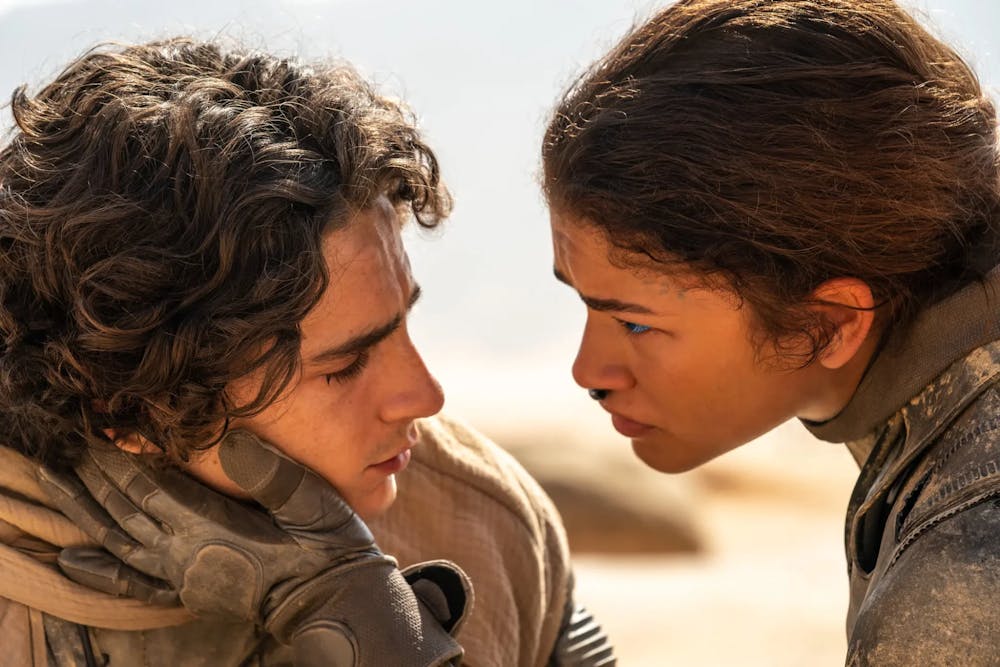Review: ‘Dune: Part Two’ is a visual and narrative spectacle

Review: ★★★★★
There have been a number of attempts to do justice to Frank Herbert’s massively influential novel, “Dune,” over the years. The most famous of these attempts include a David Lynch adaptation, notably edited in post to the point where the director himself allegedly asked for his name to be removed from the final product, and an attempt by director Alejandro Jodorowsky to make an over 10-hour version in the ’70s. Denis Villeneuve’s “Dune” and “Dune: Part Two” finally succeed in conveying the vastness and wonder of Arrakis by giving one of cinema’s modern auteurs control over a property that he had already designed storyboards for as a teenager.
For Villeneuve’s “Dune” movies, he split the original book in two. “Dune” followed the fall of House Atreides, one of the great royal families, and saw Paul (Timothée Chalamet) left in the deserts of Arrakis, the planet his family had been given by the emperor. He soon met the Fremen, a group of people indigenous to Arrakis, whom he begins to travel with as the Harkonnens, the family who took the planet from House Atreides, take control of Arrakis. While the first film was limited by its need for the source material’s world building and character development, the extensive set-up pays off in “Dune: Part Two” for an incredible viewing experience.
One of the most noticeable things about the film is cinematographer Greig Fraser’s stunning visuals, truly something that should be experienced on the biggest screen available.
Anyone who has seen “Dune” can tell you how great Arrakis looks, with primarily orange tones saturating the world. However, perhaps the most visually exciting moments are on Giedi Prime, the homeworld of the Harkonnens. Giedi Prime is shot in black and white, a decision Villeneuve said in an interview with Moviefone was inspired by the original book’s emphasis on the impact of the world around populations on their psyche and political systems. Villeneuve and Fraser took this concept and applied it to the Harkonnens, creating a world where “instead of revealing colors, the sunlight was killing them.” Rather than shooting in simple black and white, Villeneuve and Fraser shot in infrared to create something more eerie and otherworldly.
Aside from the cinematography, the film’s looks are enhanced by superb costume and set design, with elements drawing from organic structures and creating a very unique look across the film. The combination of the ancient with the futuristic adds to the visual identity of “Dune.” Countless material textures are utilized to create a sense of depth in the sets and reality in the costumes. This attention to detail is further seen in the infamous sandworms, which look monumental and dangerous.
In addition to just how eye-catching of a film “Dune: Part Two” is, the acting is remarkable, with Chalamet at his most commanding. Chalamet and Zendaya, who stars opposite him as Chani, a Fremen, have strong chemistry that is a focal point of the film as Paul navigates his connection to a Fremen prophecy that names him as their chosen one, to both his and Chani’s dismay. “Dune: Part Two” rejects the classic “chosen one” narrative, as Paul fights against building religious fervor around his perceived role as a savior. The movie does a particularly good job of deconstructing how religious fanaticism can grow and the dangers of it. Javier Bardem’s Stilgar is essential to understand this growth of religious extremism with his belief in Paul as the Lisan Al Gaib, the Fremen’s prophesied savior figure, initially treated with humor before it grows to become disturbing. Another standout among the film’s performances, Austin Butler is a chilling villain as Feyd Rautha, a cunning and brutal foil to Paul Atreides.
A well-paced movie that builds to a satisfying conclusion while nicely setting up for a third installment, “Dune: Part Two” is an visually spectacular film that begs to be seen in theaters. Through his two “Dune” movies, Villeneuve finally does justice to the book that inspired “Star Wars” and countless other classic works of science fiction.
More from The Rice Thresher

Night Market brings Taiwanese tradition to Ray’s Courtyard
Colorful strings of paper lanterns and glowing lights hung over Ray’s Courtyard amid bustling games April 13, as the Rice Taiwanese Association hosted their annual Night Market.

Meet the Magisters: Fabiola López-Durán and Carlos Martínez-Rivera on architecture, wine and student bonds
Behind an unassuming brick exterior lies abstract art, overflowing bookshelves and handcrafted wood furniture. Floor-to-ceiling windows bathe the home of Fabiola López-Durán and Carlos Martínez-Rivera in natural light.

Media to celebrate Arab voices this month
This month is Arab American Heritage Month — so what better time to highlight media created by and about the Arab world? Here are some of the best works by Arab filmmakers, musicians and writers that showcase the diversity and complexity of Arab experiences.

Please note All comments are eligible for publication by The Rice Thresher.